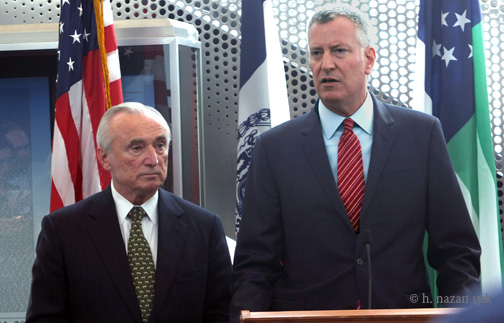h. nazan ışık—
9 October 2015—
On Thursday, 8 October, there was a swearing-in ceremony at the Police Academy in Queens. Mayor Bill de Blasio, and Police Commissioner Bill Bratton welcomed the new class of 678 recruits into the NYPD.
After the ceremony Mayor de Blasio and Commissioner Bratton held a press conference to answer on and off topic questions.
Commissioner Bratton (L), and Mayor de Blasio, after the NYPD swearing-in ceremony at the Police Academy, answering the questions.
There were a lot of questions on different topics. But the one question, came from a female journalist, caught my attention the most.
During the ceremony the Mayor emphasized “This class is one of the most diverse in the history of New York City, Recruits in this class hail from 36 different countries and speak 22 different languages, 10 percent Asian; 13 percent African American, 32 percent Hispanic.”
The question was about the considerable diversity of the class, and, in a way, the “dress code”.
Commissioner Bratton answered: “We have Sikh officers. They wear a modified headdress that basically allows them to meet the needs of their religion, to meet our needs. As you know, there are modified versions that they can wear.” He mentioned that the large headdress, the turban or the beard would interfere significantly with the safety features of fitting the gas masks.
“And similarly, Muslim female officers, would it occasion, wear the headdress that they are required to wear by their religion.” he said.
And continued: “So it’s an officer safety issue as well as other concerns, but on that end, that I’d suggest you can speak to some of our Muslim fraternal organizations”
At the ceremony Mayor de Blasio said to the recruits: “So you will be trained in the newest approaches, in the most modern approach to policing, you will be trained in the most sophisticated way to really achieve neighborhood policing.”
Other question was about what was new in training.
Commissioner Bratton answered: “This class beginning this week, a number of them are actually going out into the field, where for several weeks they will work in a precinct that they will ultimately be assigned to, where they will learn about the precinct. They will spend a day with a sergeant. They will spend a day in each of the functions of the precinct. So that’s new – the idea that even as they’re in the academy, they’re already out into the precinct, where they’re going to work. They’ll meet community members in that precinct. And then they will come back to the academy and be debriefed on their experiences out in the field – totally new.”
And he added that officers would be trained on how to deal with the mentally ill, understanding different types of drug behavior, on the new equipment that they are going to be giving.
Mayor de Blasio continued: “We’ve talked before about new technology like ShotSpotter and the smart phones, and the other devices that officers will have to be able to have information so much more quickly than ever before. We’ve talked about the training and how that’s going to teach officers better than ever before to work with community, how to use the correct use of force, showing them the right way to approach a stop-and-frisk situation.”
This answer created another question about the correct use of force.
“We need to keep the city safe. We need our officers to be effective. A lot times that can be done with less force. A lot of times there is a way to de-escalate a situation.
That’s what is being trained here – to use all the various tools that an officer has, all the different options, to figure out how to get the job done with the least possible force. It never precludes using maximum force when necessary.” said Mayor de Blasio.
This answer had a mixed message: get the job done with the least possible force. It never precludes using maximum force when necessary.
All remains to be seen! A female police officer wearing a hat and a scarf?
© h. nazan ışık
Photo © h. nazan ışık, all rights reserved.
© NKENdiKEN

